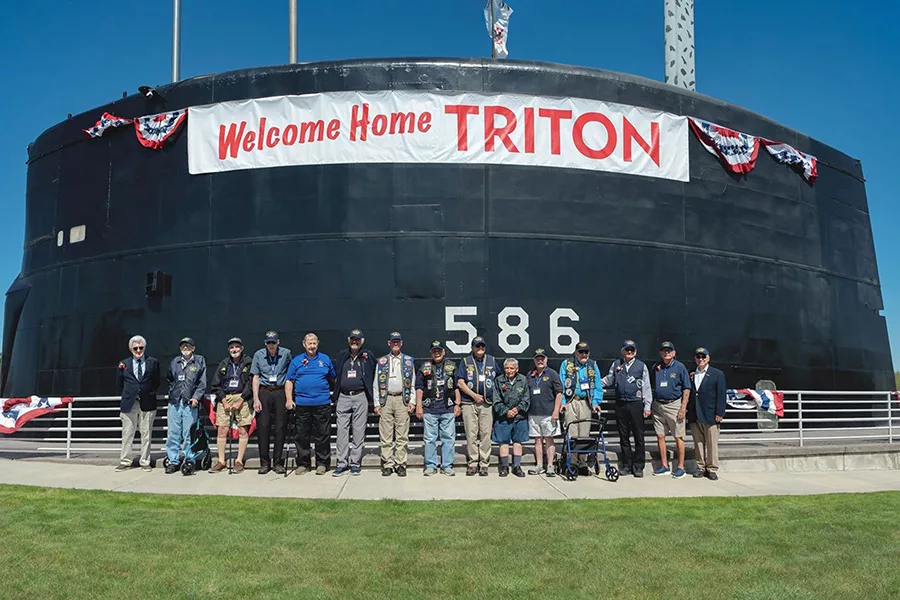
Home » Local vets among USS Triton crew honored at Richland park
Local vets among USS Triton crew honored at Richland park

Veterans of the USS Triton stand alongside the submarine’s sail and conning tower in Richland at the June 14 unveiling of a new commemorative wall honoring them and hundreds of others who served on the sub.
Courtesy Port of BentonJuly 1, 2025
After making its way around the world in the 1960s as a part of Operation Sandblast, the first mission to circumnavigate the earth underwater, a portion of the submarine USS Triton came to rest in Richland.
Now, 13 years after the establishment of Triton Sail Park, home to the submarine’s sail and conning tower, a commemorative wall has been installed to honor the 857 crew members who served aboard the Triton in its 10 years of service.
More than a dozen Triton veterans attended the June 14 ceremony held by the Port of Benton, sharing stories of their time on the submarine, which was underway from 1959-69. Two veterans are Tri-Citians: Retired Capt. Jim Carey, 82, and first-class machinist’s mate Joe Tarcza, 81, both of Kennewick.
Triton’s local veterans
How did the Triton’s sail end up in Richland, far inland from the oceans it once navigated? The park that serves as its home at 3250 Port of Benton Blvd. overlooks the dock where the Navy transfers nuclear reactor compartments from decommissioned vessels for delivery to the Hanford site, where they are permanently stored.
The Triton is one of those vessels. It was the first and only U.S. submarine to be powered by two reactors and featured the largest sail ever on a U.S. submarine, 75 feet long and 20 feet tall. It also was the last U.S. submarine to have a conning tower, according to port information.
Carey said the reason for the sail’s size was to house large radar equipment, but “by the time … they went around the world submerged, which was their historic mission, and by the time they got operating,” the need for these types of radar submarines had gone away.
The Triton was the longest and most powerful submarine of its day. Carey recalled the first time he dove the Triton. He had to check that all of the vents were shut. A diesel submarine had about six ballast tanks, the Triton had 12, leaving Carey looking out at a startlingly long row of vents on his first dive.
While the Triton is best known for its Operation Sandblast voyage, which earned the submarine a Presidential Unit Citation, the ship also earned a Navy Unit Commendation for missions which are still classified.
Tarcza recalled receiving the citation while serving on the USS Abraham Lincoln. “People don’t know much about it because it’s still secret … but that was, in my mind, just as important at that time as what they did for Sandblast,” he said.
Time on the Triton
Carey and Tarcza briefly overlapped during their time on the Triton but never met each other until they both served on the Abraham Lincoln.

Jim Carey
Carey was commissioned in 1964, a graduate of the University of Nebraska ROTC program. He reported to the Triton in 1966 and stayed until a few months before it was decommissioned in 1969.
He had worked on the prototype for the Triton during nuclear training on the East Coast and read “Around the World Submerged: The Voyage of the Triton,” penned by the Triton’s captain, Edward Beach, in 1962.
Looking to serve on a nuclear boat in particular, Carey chose the Triton upon completing his training.

Joe Tarcza
Tarcza joined the military after graduating high school, originally hoping to be an engineman. He ended up as a boilerman instead, then was asked if he had interest in the nuclear power program. Though Tarcza didn’t know much about it at the time, he agreed to sign up to serve on a submarine.
He spent two and a half years on the Triton, from 1964-66, most of the time out at sea, he said.
Both Carey and Tarcza spent much of their time aboard the Triton getting submarine qualified, but there were fun elements as well.
Tarcza remembered trying to make wine with his lead petty officer by adding water, sugar and yeast to freeze-dried fruit in a polyethylene bag. Less than a day later, the mixture exploded because of the CO2 buildup. Tarcza said it stank, but that they were able to clean it up before anyone noticed.
Stops in Caribbean ports and receiving 120-character “family grams” from home are also among Tarcza’s fond memories from his time aboard the Triton.
Tri-Cities reunion
Carey went on to serve on five other submarines before retiring from the Navy in 1991 as a captain. Originally from Pennsylvania, he came to the Tri-Cities to work in operations at Hanford.
Tarcza left the Navy as a machinist’s mate in 1971 and also ended up in the Tri-Cities in the ’80s after working for an insurance company which did boiler and pressure vessel inspections.
When he interviewed for work at the Hanford site, he learned that his interviewer had served aboard the Triton as well. The nuclear background of many submariners meant there were a lot of them at the site, Tarcza said.
The Triton “follows me wherever I go,” Tarcza said.
Carey said he likes having a piece of the Triton in the area. “That’s real special for me,” he said.
Tarcza said that the Port of Benton called on him and Carey to help figure out how to put the Triton sail together when it was moved to the north Richland park, and Tarcza recalled the port gathering oral histories from those who served during Operation Sandblast.
The recent dedication was like a reunion, Tarcza said, with several meetups throughout the weekend. “It’s amazing. I still keep in touch with some of them,” he said.
Senior Times
KEYWORDS July 2025





